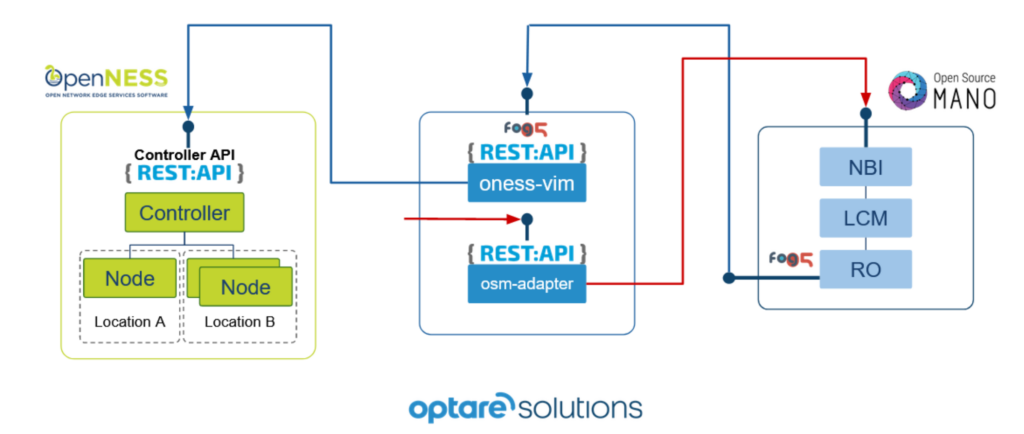Optare Solutions has successfully validated the integration of Edge Computing services provided by a platform such as Openness with the virtualization platform that Telefonica OSM has generated, aligned with ETSI standards. For this, the latest versions of both technological components have been used within the 5TONIC scenario. The goal is to manage Edge Computing services from the OSM environment so that you have a unified view of the services offered and you can use the policies of the applications in the Edge environment from a common component. The project will also evaluate the context change capabilities of the services deployed at edge for mobility scenarios..
 Cloud services have supposed an important advance in the technological adoption necessary to carry out the digitization of our environment. The ease way which cloud services are deployed and the feeling of having unlimited resources with easy provisioning has generated new business models, based in many cases in software as a service capabilities. This model has been extended to all sectors, but in some cases, these capacities are not sufficient to carry out certain actions in companies’ business processes, especially in the industrial field to complement the Industry 4.0 paradigm.
Cloud services have supposed an important advance in the technological adoption necessary to carry out the digitization of our environment. The ease way which cloud services are deployed and the feeling of having unlimited resources with easy provisioning has generated new business models, based in many cases in software as a service capabilities. This model has been extended to all sectors, but in some cases, these capacities are not sufficient to carry out certain actions in companies’ business processes, especially in the industrial field to complement the Industry 4.0 paradigm.
Cloud environments are in remote locations from where the service is provided and therefore aspects such as latency or availability in local territories to ensure compliance with data protection laws cannot be satisfied. As a consequence to solve these restrictions, the use of Edge Computing technology has been proposed to provide the availability capabilities of the cloud service, combining with the availability of services in areas close to service consumption. But the deployment of Edge Computing has run into the difficulty of its economic viability due to the cost incurred in installing the necessary resources in multiple dispersed locations. Furthermore, the set of customers and therefore the value services generated are small.
But this scenario is changing with the arrival of 5G technology that promises high capacities in data transfer, low latency and connectivity of a multitude of devices, which causes the need to arrange the service elements with a finer capillarity, probably reaching be deployed in all service access elements such as fixed exchanges and base stations in the case of mobile. At this time, operators consider that the integration between their network virtualization systems must be compatible and complementary with Edge Computing’s management systems so that it can automate and optimize the management processes globally to proceed to offer the new services associated with 5G. At this point, the application of different types of policies associated with the resources provided by different cloud and / or edge computing providers for the optimization of end-user services and applications stand out.
Multi-Access Edge Computing (MEC) applications need a management element that facilitates the redirection of traffic from client devices to the most optimal edge location or the use of the cloud context. As shown in the figure, for example, to perform the redirection of traffic on a network, it is necessary to deploy the component that allows anchoring to the network (SGW (4G) and UPF (5G)) to which the terminal is associated, at the edge [1].

Figure: Integrated EDGE components deployment
In order to extend the capabilities of NFV-based environments and provide them with the improvements provided by edge computing, Optare Solutions has carried out one of the first real MEC-NFV integrations, so that operators can equip their infrastructures NFV of the ability to manage computing resources at the edge and thus generate policies in accordance with this ability.
The ETSI defines a variant of its MEC architecture combined with the NFV architecture [2, 3] which therefore integrates the MEC scope with the MANO orchestration. There are proposals to implement this architecture, for example in ONAP [4] or other solutions such as the one developed in the 5GCAR project on Eclipse fog05 [5], or in the 5Growth project [6]. In practice it is still a work in progress to carry out this integration in the main MANO orchestrators [7].
Optare Solutions has collaborated in the project with the GTI group of the atlanTTic research center of the University of Vigo. It has been carried out in the context of 5TONIC, a project founded by Telefonica and IMDEA Networks as a 5G technology laboratory, and the orchestration platform of the 5GVINNI project of 5TONIC has been used, in direct collaboration with the Carlos III University of Madrid (UC3M). In the demonstration, it was possible to include in the NFV Open Source MANO (OSM) orchestration platform in its version 7, the Edge OpenNESS management platform, so that the life cycle orchestration of MEC applications is carried out automatically from OSM and thus allow to use policies that take into account the virtualized network environment and the edge. In this version of OSM it is possible to use the kubernetes technology, the docker container orchestrator, as VIM and this capacity has been used to optimize the deployment.
 Figure: Integration of OSM-OpenNess components
Figure: Integration of OSM-OpenNess components
The integration carried out includes the extension of the fog05 connector present in version 7 of OSM and its adaptation to the management and control APIs of the edge that OpenNESS offers, so that NFV services can be instanced on the edge from the OSM itself in a transparent way and unified. The result of the developed project shows a practical scenario made up of OSM, the Edge OpenNESS platform consisting of 2 nodes (each located in a different location) and a cluster of kubernetes that is used as a virtualization infrastructure for OSM as a VIM. This scenario solves a very common problem in which a device connected to the network perceives a high latency during the access to an application (or to another IP address). In this case, OSM deploys a new SGW in an “edge” environment close to the device in a matter of seconds, redirecting traffic from the device to that new SGW without interrupting its communications or context [8]
Additionally, in this experiment, leading developments involving new contributions were made:
- OSM 7, deploying the network core on kubernetes, which required the use of a Container Network Interface (CNI) plugin modified so as to allow connectivity between the deployed network components, as well as with the access network components
- OpenNESS-OSM adapter, which allowed the OSM language of its fog05 connector to be translated into the OpenNESS language of the edge.
- SGW deployed on the OpenNESS platform through OSM, allowing a lower latency connection between devices connected to the base station near the edge node, or reducing the latency between the device and the potential applications that are deployed in OpenNESS.
For Xosé Ramón Sousa, Optare’s direction of innovation, “We continue to demonstrate the capabilities in the integration of Edge Computing technology, generating one of the first real tests of integration of the operator virtualization environment with an Edge Computing manager allowing the application of intelligent policies to applications deployed in an automated way, thus optimizing user applications and coordinated management of Edge resources and virtualization. Thanks to this demonstration with Telefonica, we can now extend our experience to the 5G context, where Optare has spent years working on the integration of the technologies that surround it ”
Diego Lopez, Head of Technology Exploration at the GCTIO of Telefonica: “Telefonica is accumulating first-hand experience on the real possibilities that Edge Computing technologies provide, and in this case we evaluate its integration with the capabilities of a service manager of virtualized network, what we usually call an orchestrator. This combination is very interesting for the operator, since it allows managing the entire life cycle of the offered service, simplifying the incorporation of Edge Computing through our OSM orchestrator. The project will allow us to evaluate the true possibilities of this integration and to progress in the adoption of high-value services in the field of 5G ”
About Optare Solutions: Optare Solutions is a leading systems integration company, working exclusively for telecommunications operators worldwide since 2002. Optare offers top quality services in service delivery and assurance processes. It also offers its own solutions for data analytics and QoE (Quality of Experience) optimization perceived by customers and support for deployment of Edge Computing technology. Optare has more than 130 employees in its offices in Spain and Mexico. It offers training, specialized consulting, implementation, support and maintenance worldwide. It is currently focused on Europe, the Middle East and Latin America.
About Telefonica: Telefonica is one of the largest telecommunications companies in the world by market capitalization and number of clients, which relies on a comprehensive offer and on the quality of connectivity provided by the best fixed, mobile and broadband networks. It is a growing company that offers a differential experience, based both on the values of the company itself and on a public position that defends the interests of the client. The company is present in 24 countries in Europe and Latin America and has more than 344 million accesses. Telefonica is a totally private company whose shares are listed on the continuous market of the Spanish stock exchanges and on the New York and Lima stock exchanges.
References
[1] Giust, F., Verin, G., Antevski, K., Chou, J., Fang, Y., Featherstone, W., Fontes, F., Frydman, D., Li, A., Manzalini, A. and Purkayastha, D., 2018. MEC deployments in 4G and evolution towards 5G. ETSI White Paper, 24, pp.1-24.
[2] ETSI: ETSI GS MEC 003 Multi-access Edge Computing (MEC); Framework and Reference Architecture, V2.1.1. ETSI MEC ISG, January 2019.
[3] ETSI, G., 017; Mobile Edge Computing (MEC); Deployment of Mobile Edge Computing in an NFV Environment. February 2018.
[4] Evgeniy Zhukov, Manoj K Nair. “Edge Automation – Potential Strategies for Deploying ONAP at Edge”. August 2018.
[5] Gabriele Baldoni. “Merging NFV and MEC, The 5GCITY approach”.
https://www.5gcity.eu/2018/11/07/merging-nfv-and-mec-the-5gcity-approach/
[6] Andres Garcia Saavedra et al. “D2.1: Initial Design of 5G End-to-End Service Platform”. November 2019.
[7] Tomaszewski L., Kukliński S., Kołakowski R. (2020) A New Approach to 5G and MEC Integration. In: Maglogiannis I., Iliadis L., Pimenidis E. (eds) Artificial Intelligence Applications and Innovations. AIAI 2020 IFIP WG 12.5 International Workshops. AIAI 2020. IFIP Advances in Information and Communication Technology, vol 585. Springer, Cham.
[8] Pablo Fondo-Ferreiro, Felipe Gil-Castiñeira, Francisco J. González-Castaño. “A Software-Defined Networking Solution for Transparent Session and Service Continuity in Dynamic Multi-Access Edge Computing”. Submitted to IEEE Transactions on Network and Service Management.

